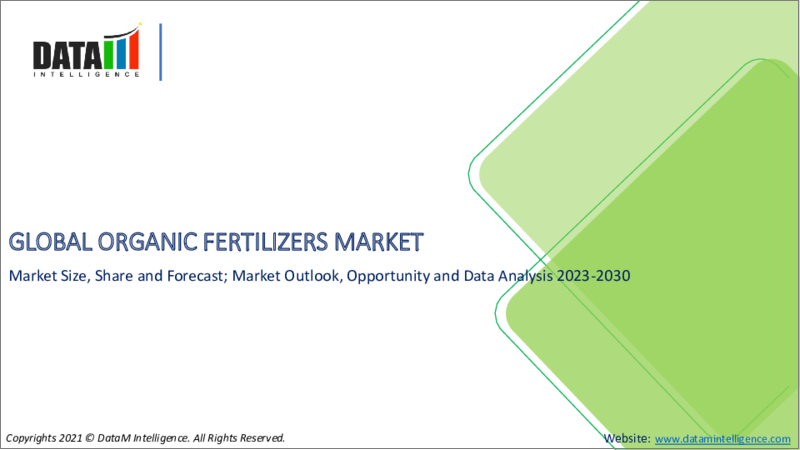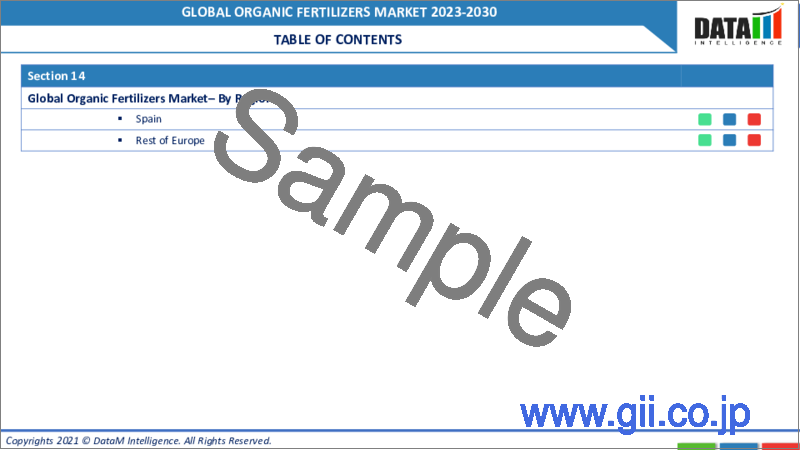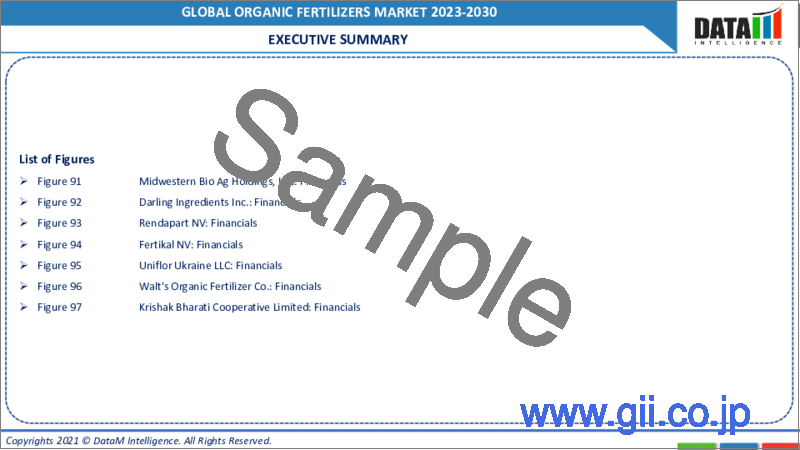|
|
市場調査レポート
商品コード
1304468
有機肥料の世界市場-2023年~2030年Global Organic Fertilizers Market - 2023-2030 |
||||||
カスタマイズ可能
適宜更新あり
|
|||||||
| 有機肥料の世界市場-2023年~2030年 |
|
出版日: 2023年07月07日
発行: DataM Intelligence
ページ情報: 英文 195 Pages
納期: 即日から翌営業日
|
- 全表示
- 概要
- 目次
市場概要
世界の有機肥料市場は、2022年に97億米ドルに達し、2030年には230億米ドルに達し、有利な成長が予測されています。予測期間2023-2030年のCAGRは11.5%と予測されます。
有機肥料は、植物に必須栄養素を供給し、土壌の肥沃度を向上させる天然物質です。合成肥料とは異なり、有機肥料は堆肥、糞尿、植物性肥料、骨粉、魚乳剤などの有機源に由来します。長期的な土壌の健全性の促進、環境負荷の低減、持続可能な農法のサポートなど、いくつかの利点があります。
有機食品に対する需要の高まりと、環境の持続可能性に対する意識の高まりが、有機肥料市場の成長を後押ししています。農家、園芸家、農業団体は、作物生産への総合的なアプローチの一環として有機肥料を採用するようになっています。その結果、有機肥料市場は今後も拡大を続けると予測されています。
市場力学
バットグアノやミミズ堆肥のような栄養豊富な有機肥料が有機肥料市場の成長を牽引
有機肥料市場の分析によると、有機肥料市場は、特にバットグアノやミミズ堆肥のような製品における栄養分の利用可能性に重点を置いています。これらの有機肥料は、植物の成長に不可欠な窒素、リン、カリウムなどの栄養素を多く含むことで知られています。バットグアノやミミズ堆肥に含まれる栄養分は、植物の健全な発育を促し、作物の収量を増加させます。
研究によると、バットグアノには最大10%の窒素が含まれ、ミミズ堆肥には最大5%の栄養分が含まれます。この高い栄養分濃度は、これらの有機肥料の有効性と、農家や園芸家の間での人気の高まりに貢献しています。持続可能で栄養価の高い肥料への需要が高まるにつれ、バットグアノ、ミミズ堆肥、その他の有機肥料の市場は拡大すると予想されます。その結果、有機肥料の市場シェアは拡大します。
血粉と緑肥作物の調達における課題が有機肥料市場の抑制要因に
有機肥料市場分析によると、有機肥料市場の主要な抑制要因の1つは、血粉や緑肥作物のような特定の有機肥料に関連する限られた入手可能性と調達の課題です。
動物の血液に由来する血粉は、その生産における倫理的・規制的配慮から供給上の制約に直面する可能性があります。同様に、窒素固定に使用されるマメ科作物などの緑肥作物は、生育に土地と時間を必要とするため、入手性に影響を与えます。
こうした要因は、有機肥料の入手可能性と価格の変動につながる可能性があり、これは有機肥料の世界市場シェアにも影響します。血粉には通常12~14%の窒素が含まれ、緑肥作物は最大150kg/haの窒素を供給することができますが、これらの作物の入手可能性に制約があるため、有機肥料の需要増に対応する上で課題となる可能性があります。
しかし、現在進行中の代替有機肥料と持続可能な農法の研究開発は、こうした抑制要因に対処し、市場で栄養豊富な選択肢の安定供給を確保することを目指しています。
COVID-19影響分析
COVID-19分析には、COVID前シナリオ、COVIDシナリオ、COVID後シナリオに加え、価格力学(COVID前シナリオと比較したパンデミック中およびパンデミック後の価格変動を含む)、需給スペクトラム(取引制限、封鎖、およびその後の問題による需給のシフト)、政府の取り組み(政府機関による市場、セクター、産業を復興させる取り組み)、メーカーの戦略的取り組み(COVID問題を緩和するためにメーカーが行ったことをここで取り上げる)が含まれます。
目次
第1章 調査手法と調査範囲
第2章 定義と概要
第3章 エグゼクティブサマリー
第4章 市場力学
- 影響要因
- 促進要因
- 抑制要因
- 機会
- 影響分析
第5章 産業分析
- ポーターのファイブフォース分析
- サプライチェーン分析
- 価格分析
- 規制分析
第6章 COVID-19分析
第7章 形態別
- 乾燥肥料
- 液体肥料
第8章 由来別
- 動物性
- 植物性
- ミネラル
- その他
第9章 用途別
- 農業
- 園芸
第10章 地域別
- 北米
- 米国
- カナダ
- メキシコ
- 欧州
- ドイツ
- 英国
- フランス
- イタリア
- スペイン
- その他欧州
- 南米
- ブラジル
- アルゼンチン
- その他南米
- アジア太平洋
- 中国
- インド
- 日本
- オーストラリア
- その他アジア太平洋地域
- 中東・アフリカ
第11章 競合情勢
- 競合シナリオ
- 市況/シェア分析
- M&A分析
第12章 企業プロファイル
- Italpollina
- 会社概要
- グレードポートフォリオと概要
- 財務概要
- 主な発展
- California Organic Fertilizers, Inc.
- Vertical N.V.
- Multiplex Group.
- BioStar Systems, LLC
- Midwestern BioAg
- Nature Safe
- Proton AG
- Perfect Blend Biotic Fertilizer
- Viano
第13章 付録
Market Overview
The Global Organic Fertilizers Market reached US$ 9.7 billion in 2022 and is projected to witness lucrative growth by reaching up to US$ 23 billion by 2030. The market is expected to exhibit a CAGR of 11.5% during the forecast period 2023-2030.
Organic fertilizers are natural substances that provide essential nutrients to plants and improve soil fertility. Unlike synthetic fertilizers, organic fertilizers are derived from organic sources such as compost, manure, plant-based fertilizers, bone meal, and fish emulsion. They offer several advantages, including promoting long-term soil health, reducing environmental impact, and supporting sustainable agricultural practices.
The increasing demand for organic food and the growing awareness of environmental sustainability has fueled the growth of the organic fertilizers market. Farmers, gardeners, and agricultural organizations increasingly adopt organic fertilizers as part of their holistic approach to crop production. As a result, the Organic Fertilizers Market is projected to continue expanding in the coming years.
Market Dynamics
Nutrient-rich Organic Fertilizers like Bat Guano and Worm Castings Drive Growth in the Organic Fertilizers Market
According to organic fertilizers market analysis, the Organic Fertilizers Market is the emphasis on nutrient availability, particularly in products like bat guano and worm castings. These organic fertilizers are known for their high nutrient content, including nitrogen, phosphorus, and potassium, essential for plant growth. The nutrient availability in bat guano and worm castings promotes healthy plant development and enhances crop yields.
Studies have shown that bat guano can contain up to 10% nitrogen and worm castings can have a nutrient content of up to 5%. This high nutrient concentration contributes to the effectiveness of these organic fertilizers and their growing popularity among farmers and gardeners. As the demand for sustainable and nutrient-rich fertilizers increases, the market for bat guano, worm castings, and other organic fertilizers is expected to expand. As a result the organic fertilizers market share is increased.
Challenges in Sourcing Blood Meal and Green Manure Crops Pose Restraint to the Organic Fertilizers Market
According to organic fertilizers market analysis, one key restraint in the Organic Fertilizers market is the limited availability and sourcing challenges associated with specific organic fertilizers like blood meal and green manure crops.
Blood meal, derived from animal blood, may face supply constraints due to its production's ethical and regulatory considerations. Similarly, green manure crops, such as legumes used for nitrogen fixation, require land and time for growth, impacting their availability.
These factors can lead to fluctuations in the availability and pricing of these organic fertilizers; this can also impact global organic fertilizers market share. While blood meal typically contains 12-14% nitrogen, and green manure crops can contribute up to 150 kg/ha of nitrogen, their constrained availability may pose challenges in meeting the growing demand for organic fertilizers.
However, ongoing research and development in alternative organic fertilizers and sustainable farming practices aim to address these restraints and ensure a consistent supply of nutrient-rich options in the market.
COVID-19 Impact Analysis
The COVID-19 Analysis includes Pre-COVID Scenario, COVID Scenario and Post-COVID Scenario along with Pricing Dynamics (Including pricing change during and post-pandemic comparing it with pre-COVID scenarios), Demand-Supply Spectrum (Shift in demand and supply owing to trading restrictions, lockdown and subsequent issues), Government Initiatives (Initiatives to revive market, sector or Industry by Government Bodies) and Manufacturers Strategic Initiatives (What manufacturers did to mitigate the COVID issues will be covered here).
Segment Analysis
The Global Organic Fertilizers Market is segmented based on form, source, application and region.
Growing Demand for Liquid Organic Fertilizers Drives Significant Market Share in the Organic Fertilizers Market
The Global Organic Fertilizers Market is segmented based on form into dry fertilizers and liquid fertilizers. The liquid fertilizers segment is a significant and rapidly growing component of the organic fertilizers market, holding a substantial market share.
With a projected annual growth rate of approximately 8%, the liquid fertilizers market analysis highlights its increasing importance in organic agriculture. Liquid fertilizers offer advantages such as higher nutrient concentration, faster plant absorption, and ease of application.
Studies have shown that liquid organic fertilizers can provide nutrient content ranging from 3% to 8%, ensuring effective plant nutrition. As farmers and gardeners embrace organic farming practices, the demand for liquid organic fertilizers is expected to continue its upward trajectory. This trend underscores the organic fertilizers market analysis, emphasizing the significance of liquid fertilizers in achieving sustainable and high-yielding organic crop production.
Geographical Analysis
Asia Pacific Organic Fertilizers Market Surges with Growing Adoption of Organic Farming Practices and Increasing Demand for Sustainable Agriculture
The Global Organic Fertilizers Market is segmented by region into Asia-Pacific, North America, South America, Europe, and Middle-east & Africa.
The Asia Pacific organic fertilizers market is witnessing significant growth, driven by the increasing adoption of organic farming practices and the rising demand for organic food products. With a growing emphasis on sustainable agriculture and environmental conservation, organic fertilizers have gained popularity in the region. The market analysis indicates a strong organic fertilizers market share in the Asia Pacific region, with a projected CAGR of around 10% in the coming years.
Although Organic Fertilizers Market trends observed the development of innovative organic fertilizers, government support for organic farming, and the expansion of organic certification programs, the rising consumer awareness regarding the benefits of organic food and the need for sustainable farming practices are expected to fuel the growth of the Organic Fertilizers Market in the Asia Pacific region.
Competitive Landscape
The major global players include: Italpollina, California Organic Fertilizers, Inc., Vertical N.V., Multiplex Group., BioStar Systems, LLC, Midwestern BioAg, Nature Safe., Proton AG, Perfect Blend Biotic Fertilizer, and Viano.
Why Purchase the Report?
- To visualize the Global Organic Fertilizers Market segmentation based on form, source, application, and Region and understand key commercial assets and players.
- Identify commercial opportunities by analyzing trends and co-development.
- Excel data sheet with numerous organic fertilizers market-level data points with all segments.
- The PDF report includes a comprehensive analysis after exhaustive qualitative interviews and an in-depth study.
- Product mapping available as Excel consisting of key products of all the major players.
The Global Organic Fertilizers Market Report Would Provide Approximately 61 Tables, 56 Figures And 195 pages.
Target Audience 2023
- Manufacturers/ Buyers
- Industry Investors/Investment Bankers
- Research Professionals
- Emerging Companies
Table of Contents
1. Methodology and Scope
- 1.1. Research Methodology
- 1.2. Research Objective and Scope of the Report
2. Definition and Overview
3. Executive Summary
- 3.1. Snippet by Form
- 3.2. Snippet by Source
- 3.3. Snippet by Application
- 3.4. Snippet by Region
4. Dynamics
- 4.1. Impacting Factors
- 4.1.1. Drivers
- 4.1.2. Restraints
- 4.1.3. Opportunity
- 4.1.4. Impact Analysis
5. Industry Analysis
- 5.1. Porter's Five Force Analysis
- 5.2. Supply Chain Analysis
- 5.3. Pricing Analysis
- 5.4. Regulatory Analysis
6. COVID-19 Analysis
- 6.1. Analysis of COVID-19
- 6.1.1. Scenario Before COVID-19
- 6.1.2. Scenario During COVID-19
- 6.1.3. Post COVID-19 and Future Scenario
- 6.2. Pricing Dynamics Amid COVID-19
- 6.3. Demand-Supply Spectrum
- 6.4. Government Initiatives Related to the Market During the Pandemic
- 6.5. Manufacturers' Strategic Initiatives
- 6.6. Conclusion
7. By Form
- 7.1. Introduction
- 7.1.1. Market Size Analysis and Y-o-Y Growth Analysis (%), By Form
- 7.1.2. Market Attractiveness Index, By Form
- 7.2. Dry fertilizers*
- 7.2.1. Introduction
- 7.2.2. Market Size Analysis and Y-o-Y Growth Analysis (%)
- 7.3. Liquid fertilizers
8. By Source
- 8.1. Introduction
- 8.1.1. Market Size Analysis and Y-o-Y Growth Analysis (%), By Source
- 8.1.2. Market Attractiveness Index, By Source
- 8.2. Animal-based*
- 8.2.1. Introduction
- 8.2.2. Market Size Analysis and Y-o-Y Growth Analysis (%)
- 8.3. Plant-based
- 8.4. Minerals
- 8.5. Others
9. By Application
- 9.1. Introduction
- 9.1.1. Market Size Analysis and Y-o-Y Growth Analysis (%), By Application
- 9.1.2. Market Attractiveness Index, By Application
- 9.2. Farming*
- 9.2.1. Introduction
- 9.2.2. Market Size Analysis and Y-o-Y Growth Analysis (%)
- 9.3. Gardening
10. By Region
- 10.1. Introduction
- 10.1.1. Market Size Analysis and Y-o-Y Growth Analysis (%), By Region
- 10.1.2. Market Attractiveness Index, By Region
- 10.2. North America
- 10.2.1. Introduction
- 10.2.2. Key Region-Specific Dynamics
- 10.2.3. Market Size Analysis and Y-o-Y Growth Analysis (%), By Form
- 10.2.4. Market Size Analysis and Y-o-Y Growth Analysis (%), By Source
- 10.2.5. Market Size Analysis and Y-o-Y Growth Analysis (%), By Application
- 10.2.6. Market Size Analysis and Y-o-Y Growth Analysis (%), By Country
- 10.2.6.1. The U.S.
- 10.2.6.2. Canada
- 10.2.6.3. Mexico
- 10.3. Europe
- 10.3.1. Introduction
- 10.3.2. Key Region-Specific Dynamics
- 10.3.3. Market Size Analysis and Y-o-Y Growth Analysis (%), By Form
- 10.3.4. Market Size Analysis and Y-o-Y Growth Analysis (%), By Source
- 10.3.5. Market Size Analysis and Y-o-Y Growth Analysis (%), By Application
- 10.3.6. Market Size Analysis and Y-o-Y Growth Analysis (%), By Country
- 10.3.6.1. Germany
- 10.3.6.2. The U.K
- 10.3.6.3. France
- 10.3.6.4. Italy
- 10.3.6.5. Spain
- 10.3.6.6. Rest of Europe
- 10.4. South America
- 10.4.1. Introduction
- 10.4.2. Key Region-Specific Dynamics
- 10.4.3. Market Size Analysis and Y-o-Y Growth Analysis (%), By Form
- 10.4.4. Market Size Analysis and Y-o-Y Growth Analysis (%), By Source
- 10.4.5. Market Size Analysis and Y-o-Y Growth Analysis (%), By Application
- 10.4.6. Market Size Analysis and Y-o-Y Growth Analysis (%), By Country
- 10.4.6.1. Brazil
- 10.4.6.2. Argentina
- 10.4.6.3. Rest of South America
- 10.5. Asia-Pacific
- 10.5.1. Introduction
- 10.5.2. Key Region-Specific Dynamics
- 10.5.3. Market Size Analysis and Y-o-Y Growth Analysis (%), By Form
- 10.5.4. Market Size Analysis and Y-o-Y Growth Analysis (%), By Source
- 10.5.5. Market Size Analysis and Y-o-Y Growth Analysis (%), By Application
- 10.5.6. Market Size Analysis and Y-o-Y Growth Analysis (%), By Country
- 10.5.6.1. China
- 10.5.6.2. India
- 10.5.6.3. Japan
- 10.5.6.4. Australia
- 10.5.6.5. Rest of Asia-Pacific
- 10.6. Middle East and Africa
- 10.6.1. Introduction
- 10.6.2. Key Region-Specific Dynamics
- 10.6.3. Market Size Analysis and Y-o-Y Growth Analysis (%), By Form
- 10.6.4. Market Size Analysis and Y-o-Y Growth Analysis (%), By Source
- 10.6.5. Market Size Analysis and Y-o-Y Growth Analysis (%), By Application
11. Competitive Landscape
- 11.1. Competitive Scenario
- 11.2. Market Positioning/Share Analysis
- 11.3. Mergers and Acquisitions Analysis
12. Company Profiles
- 12.1. Italpollina
- 12.1.1. Company Overview
- 12.1.2. Grade Portfolio and Description
- 12.1.3. Financial Overview
- 12.1.4. Key Developments
- 12.2. California Organic Fertilizers, Inc.
- 12.3. Vertical N.V.
- 12.4. Multiplex Group.
- 12.5. BioStar Systems, LLC
- 12.6. Midwestern BioAg
- 12.7. Nature Safe
- 12.8. Proton AG
- 12.9. Perfect Blend Biotic Fertilizer
- 12.10. Viano
LIST NOT EXHAUSTIVE
13. Appendix
- 13.1. About Us and Services
- 13.2. Contact Us





